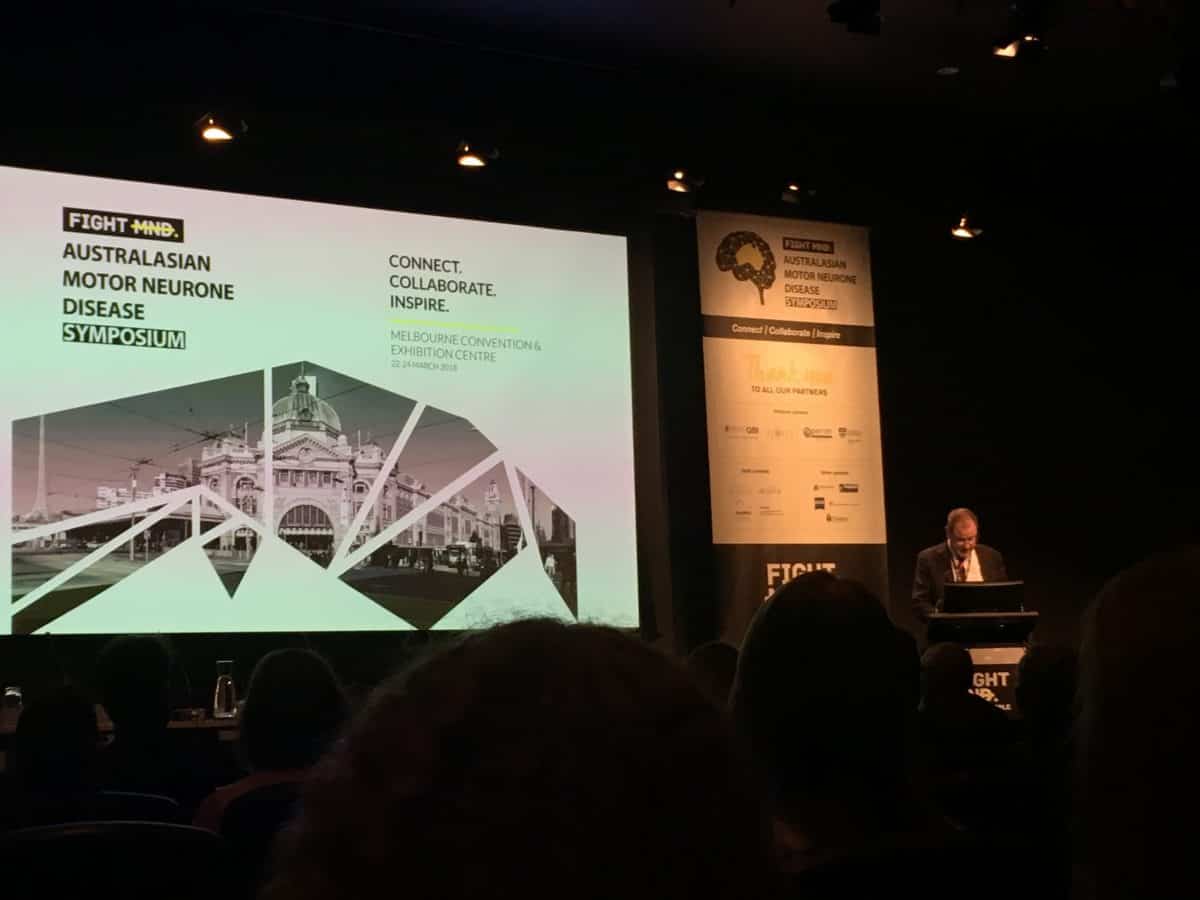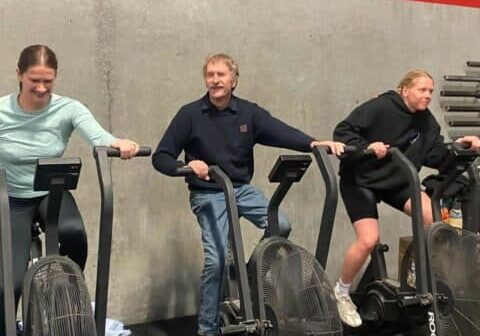Australasian MND Symposium – live blog (Day 1)
Genetics, Research
22 March 2018

Live updates from the Australasian MND Symposium, March 22, 2018.
Written by a non-scientist for a layperson audience. This means we're skipping the complicated science and going straight for the highlights.
Typing fast and editing slow, so excuse spelling mistakes. The team from MND New Zealand are at the inaugural Australasian MND Symposium hosted by Fight MND. We will be bringing you live updates over the next three days – mostly from the biomedical stream, which covers the latest in MND research.
Our support team members are attending the clinical sessions, and we will bring you updates from these over the following few days.
8:40am
Federal Health Minister – The Hon Greg Hunt MP
The rate of MND diagnoses has doubled in the last 20 years in Australia. There are now over 2000 people living with MND in Australia.
There is $31.7 million available to MND research in Australia. This is split between primary research into causes, bringing young researchers through clinical fellowships, and pre-clinical trials.
The Medical Research Future Fund has $4.8 million.
Australia is currently running 19 clinical trials related to neurology.
He’s also acknowledged that mental health in MND is important – it’s not just a physical challenge, it’s a mental one. #AusMNDS18
— MND New Zealand (@mndanz) 21 March 2018
9am
Prof Matthew Kiernan – MND in Australia
It’s a very exciting time to be involved in MND research. There’s a lot of hope and positivity, says Prof Kiernan. #AusMNDS18
— MND New Zealand (@mndanz) 21 March 2018
Australia and New Zealand are part of PACTALS, the Asia-Pacific consortium for MND/ALS research. The region includes 55-60% of the world's population so there is huge potential for research here.
Being part of an international clinical trials network is also very important – it helps them try to attract international pharma to Australia.
There are multiple trials being planned that involve international collaboration.
One interesting clinical trial is looking at HIV therapies as an anti-inflammatory approach to MND.
Prof M Kiernan acknowledges the importance of biomarkers in motor neurone disease research and the need to incorporate a biomarker arm into all clinical trials #AusMNDS18 @Flinders_RDS pic.twitter.com/wkQ11deBuq
— Carmela Sergi (@carmela_sergi) 21 March 2018
Other important research looks at pre-symptomatic individuals who are positive for Familial MND genes. These have shown changes to personality before the development of motor changes.
The current thinking about MND is that it begins focally, then spreads along neural pathways. This could lead to the development of regional therapy to contain the spread.
9.30am
Prof Ammar Al-Chalabi – What causes MND?
Prof Amman Al-Chalabi is speaking about causes of MND. He’s one of the worlds leading researchers in MND and is showing an MRI of the inside of his own brain. #AusMNDS18
— MND New Zealand (@mndanz) 21 March 2018
The differentiation between familial and sporadic ALS is not as clear as once thought.
There is no consistent definition of familial ALS. All fALS genes have been found in people with sporadic ALS. We've also found other relevant diseases that affect how we define fALS: frontotemporal dementia, schizophrenia, ataxia.
The terms familial ALS and sporadic ALS are outdated and illogical, says @AmmarAlChalabi –and it's time to ditch them. #ALS #MND https://t.co/TKD6WFdolh pic.twitter.com/XDLBsZnjJw
— Nature Outlook (@NatureOutlook) 6 March 2018
People with fALS have younger onset of MND by about 5 years.
60% of whether or not you get MND is genetic factors, 40% is environmental.
We now know of 25 risk genes for MND. At the rate of discovery, in four years we will have found 50. (Each of these risk factors increase your risk of MND by 5-10%).
It's much harder to identify environmental risk factors than to find genetic risks. Recall is a problem!
Environmental risk factors that many (not all) studies have agreed on are: smoking, trauma (eg broken bone, surgery), diesel fumes, exercise, being a war veteran.
It seems very likely that developing MND is a multistep process. Studies that map MND against age in the UK, Netherlands, Italy, Ireland and Scotland have all shown that this is very likely and about 6 molecular steps are required for MND to happen.
Taking lessons learnt in cancer, @AmmarAlChalabi describes #ALS #MND as a multistep process where genetic risk & environmental factors accumulate over time until threshold of disease is reached #AusMNDS18
— Aus MND Symposium (@AUS_MND) 21 March 2018
A potential staging system for MND – similar to the way cancer is defined in stages. #AusMND2018 pic.twitter.com/QdV95sJ2mI
— MND New Zealand (@mndanz) 21 March 2018
This approach lets us look at which stage rilzole treats. It appears that it may have no effect in the middle stages. Riluzole prolongs the final stage of MND. It may also prolong the first stage but we have no data so this effect is unknown.
BIOMARKERS SESSION
10:50am
Prof Robert Bowser – Discovery and Use of Biomarkers for MND/ALS
In 2005 early profile of cerebrospinal fluid looked for biomarkers for ALS – probably the first use of these types of technologies.
Oncology is always ahead of MND research, this approach had been used for cancer for a decade already.
Now bio samples from well over 3000 subjects in different studies can be used to identify biomarkers.
Neurofilament proteins are a known biomarker for MND – a prognositic marker too, that may help predict survival. Levels are higher in people with familial C9ALS.
Neurofilament protein-based tests are now being commercialised and used in clinical trials. Testing will be available in the US this year, and is already available in Europe.
We also need other types of biomarkers to reflect the different mechanisms of MND eg for neuro-inflammation.
Describing biomarkers as a toolkit that will allow us to track biochemical changes in disease progression, guide patient enrollment in clinical trials & monitor drug efficacy #AusMNDS18 pic.twitter.com/LLU8SYsK15
— Aus MND Symposium (@AUS_MND) 22 March 2018
Analysis of cerebrospinal fluid from people with fast and slow progressing MND found that the groups had different levels of the biomarker chitinase.
Biomarkers can be used to identify changes to specific cells types in MND, which could be used to choose the patients who will best fit clinical trials. In future biomarkers will be used to define patients that will best respond to a particular treatment.
Artificial intelligence can now be used to find biomarkers, combine datasets and clinical information to create a precision medicine approach.
11:20am
Mary-Louise Rogers – Validation of urinary biomarker p75
Major barrier to successful clinial trial is the insensitivity of outcome measures. We need markers to measure the effectiveness of any treatment.
p75 is a neurotrophin receptor that is expressed following nerve injury. It has long been known to be found in MND. Injured nerves shed p75, then appears in urine.
Urinary p75 is significantly higher in people with MND. It's also easy to measure and not invasive to collect.
p75 is also raised in cerebrospinal fluid in people with MND and may also be raised in blood serum. This sows that it must be present in the fluid that bathes the spinal cord as the motor neurons are degenerating.
Research then looked at whether levels of urinary p75 changed over time and therefore could mark disease progression and prognosis.
Urinarly p75 levels did increase in each patient as disease progressed, as motor function declined. There was a correlation between p75 and the ALSFRS (which is a more subjective measure currently used to measure progression in clinical trials).
p75 is also a predictor of survival: high baseline p75 is a predictor of worse survival.
Now being used in some clinical trials. It's an opportunity to get further validation of the use of p75 in clinical trials.
.@MLRogers123 @Flinders gives #AusMNDS18 an update on her work to validate the urinary p75ECD biomarker. Great to see that it's being incorporated in clinical trials here in Aus, collaboration in action! #ALS #MND pic.twitter.com/apT6uKgBMC
— Aus MND Symposium (@AUS_MND) 22 March 2018
11:30am
Wouter van Rheenan – Whole blood transcriptome analyses
The search for a diagnostic and predictive biomarker in the Netherlands.
Blood is drawn at first visit (pre-diagnosis). They looked at the genes that were deferentially expressed in people with MND compared to healthy controls.
(This is a highly scientific presentation so I'll only write down what I understand… not much so far…)
More work need to be done to make sure results are more specific for MND. They are uploading their data to make it available to other researchers around the world.
(It's great to see this sharing of data and IP to advance research into MND!)
11:50am
Prof Michael Benatar – The role of biomarkers in therapy development
There is a plethora of candidate biomarkers. It's important to develop only those that are fit for purpose. There are four purposes for biomarkers: diagnostic, prognostic, predictive, pharamacodynamic.
- Diagnostic biomarkers: Tests with high sensitivity are needed. We need to test the biomarkers in populations where a diagnosis of MND is unknown. We really need to get people to a neurologist as quickly as possible if MND is suspected.
- Predictive biomarkers are mostly restrcited to genetic markers so far. We urgently need biomarkers that reflect the underlying biology of MND, to guide more taregetted clinical trials.
- Prognostic biomarkers need to add value to what we can already tell.
- Pharmacodynamic biomarkers indicate a biological response to drugs or disease progression. Need to fully understand what things look like without treatment, to truly see the impact of a treatment.
It's important to establish the intended clinical use of any biomarker and conduct large population studies similar to clinical trials. This is the next step for p75 and Neurofilament protein biomarker development.
For future development of biomarkers, need to have a heavy focus on what the potential future application will be.
12:05pm
Q&A
Someone pointed out that measurements of biological biomarkers may change depending on how hydrated people are and other variables. The answer is that to be successful in practice, any biomarker relationship needs to be strong enough to hold up to this kind of individual variability.
Is there a difference in biomarkers between young and old people? A number of markers change over time in humans, this is ideally incorporated in data analysis.
GENETICS SESSION
1:30pm
Prof Naomi Wray – Making sense of big data
.@WrayNaomi talked about methods to match data from independent data sets & the need to maximise sample size in genomic studies “Every person counts” #AusMNDS18
— Aus MND Symposium (@AUS_MND) 22 March 2018
Big data is important because of precision medicine initiatives – tailoring medicine to the individual. Big data can help separate patients into groups.
Is big data overhyped? Results from machines are only as good as the data that go in. Need to maximise the number of people in the data and minimise confounders.
Salsa Systems Genomics Consortium was awarded a grant after the Ice Bucket Challenge in 2015. Now launched in sites all over Australia. Collects hundreds of biological samples in 3 labs working to consistent protocols. Soon to start screening for known genetic mutations. About to launch environmental questionnaire (linked to European studies and census data). This will build up multiple layers of data for the same people.
“Omics” measures things that differ over time – either a cause of consequence of MND.
It's only if we have many risk factors to our genomic profile that we are at risk of disease.
When we understand more genes associated with MND, they can be correlated. This lead to last year's paper showing a correlation between MND and schizophrenia. You can also start mapping which specific cells are involved in disease.
2:10pm
Anthony Akkari – Genomic structural variations in ALS genomic regions
Currently only 2 therapeutics approved for MND that have a limited effect (riluzole and edaravone).
18 clinical trials have failed in the last decade alone.
We have no diagnostics to predict who will respond to the drug and how to select those patients.
Working on developing new morpholino antisense oligonucleotide (PMO) therapeutics and novel biomarkers called structural variations (SVs) that improve chances of success.
PMO therapeutics are suitable for a proportion of ALS patients. A PMO drug developed for Duchene Muscular Dystrophy received FDA approval in 2016.
High failure rate will continue if we continue using past approaches to ALS therapeutics development. Antisense oligonucleotide technologies are essential.
This is getting very technical so heading upstairs for a clinical session…
RESPIRATORY SESSION
2:30pm
Prof Mark Howard – Non-invasive ventilation in MND, when to start and when to stop
Non-invasive ventilation isn't like taking a pill – it has a big impact on the life of the person with MND and the people around them.
One of the key symptoms of a weak diaphragm is difficulty breathing when lying flat (orthopnoea) – because gravity doesn't help. This contributes to poor sleep at night-time.
Other reasons for referring for ventilation are: dyspnoea (laboured breathing), morning headache, daytime sleepiness, as well as clinical measures of oxygen shortage.
With non-invasive ventilation – when you breathe, you get a bigger breath.
NIV can improve quality of sleep, total sleep time (an extra 44 minutes), reduces feeling of breathelssness when lying flat.
Someone who wants to survive as long as possible and stay active would start NIV early. Someone who just wants to feel most comfortable will start when it may relieve symptoms that bother them. For some people it isn't appropriate or helpful.
Some people love it, some people hate it.
NEUROINFLAMMATION SESSION
3:30pm
Prof Stanley Appel – Suppressing neuroinflammation – cell-based therapy
Each time a new gene is implicated in MND, it gives us a new process that might be impaired.
As you look at each process, you see that beyond the initial damage, cells seek ‘help' from other cells. Signalling beyond the motor neuron contributes to the cell's death, because it appears motor neurons don't die alone.
In a mouse model of mSOD1 ALS, there are slow and fast progressing types. The fast progressing have higher inflammation.
T-cells suppress neuroinflammation in the mouse model. In humans, regulatory T cells correlate with a slower rate of disease progression in pwMND. These “Tregs” are protective in pwMND. FoxP3 cells are also dysfunctional in pwMND.
Total immunosuppression doesn't work. You need to change the ratio of “bad guys” to “good guys”, to increase the regulatory T cells.
Infusions of patients own Tregs on 3 pwMND normalised the rate of progression. Doing it again 16 weeks later (once a month for four months) again stabilised progression. Progression increased after treatment stopped (possible disease acceleration).
So this was a positive result but not an effective long-term therapy because it lasted only 2-6 weeks. Only 3 patients for far and not placebo controlled.
A placebo controlled trial is now planned for six months, with dose escalation and infusions for one year.
Prof Stanley Appel says pilot study @MethodistHos has shown that cell-based therapy to suppress neuroinflammation is safe & well-tolerated: infusions of autologous Treg cells restore immune cell function #AusMNDS18 @FightMND
— Aus MND Symposium (@AUS_MND) 22 March 2018
Anthony White – Developing a human 3D brain cell model
Microglia are brain macrophages that enter our brain in the embryonic stage. They respond to cell death. The c9orf72 region is important to microglial cells.
Microglial targeted drugs have not yet translated into successful clinical outcomes. This is because there are differences between animal and human microglia, and microglia are highly sensitive to their local environment.
New human cell models have been created from induced pluripotent stem cells (iPSC). This is expensive! ($10,000/cell/6 months)
You can also induce microglia-like cells from blood monocytes. This is much cheaper ($50/sample)
I'm afraid the stuff about the 3D model got a bit complicated for this reporter's understanding!
4:15pm
John Lee – The pathogenic role of complement C5a receptor
The complement system is an innate immune system, a component of blood.
C5a and C5aR1 are the most potent inflammatory mediators. The C5aR1 protein increases in the microglia in the spinal cord of SOD1 mice in the later stages of MND.
In mice, the genetic absence of C5aR1 increased survival and improved motor function. The C5aR1 protein can also be knocked out in a mouse model with an irreversible drug – PMX205 – that can be taken orally and crosses the blood-brain barrier. The PMX205 treatment improved muscle strength.
They also collected blood from pwMND and showed that C5a levels were elevated in plasma and leukocytes. C5aR1 is also elevated in pwMND monocyte populations.
4:30pm
Prof Luis Berbeito – Cellular targets on masitinib in a rat ALS model
Masitinib is currently in clinical trials for asthma, MS, AD and ALS. It targets mast cells. It can control microphages and microglia.
Mast cells infiltrate the muscles of humans with MND. Masitinib prevents this mast cell and macrophage infiltration into muscles in rats with ALS.
There is hope for this drug class (tyrosine kinase inhibitors) for slowing MND progression.


